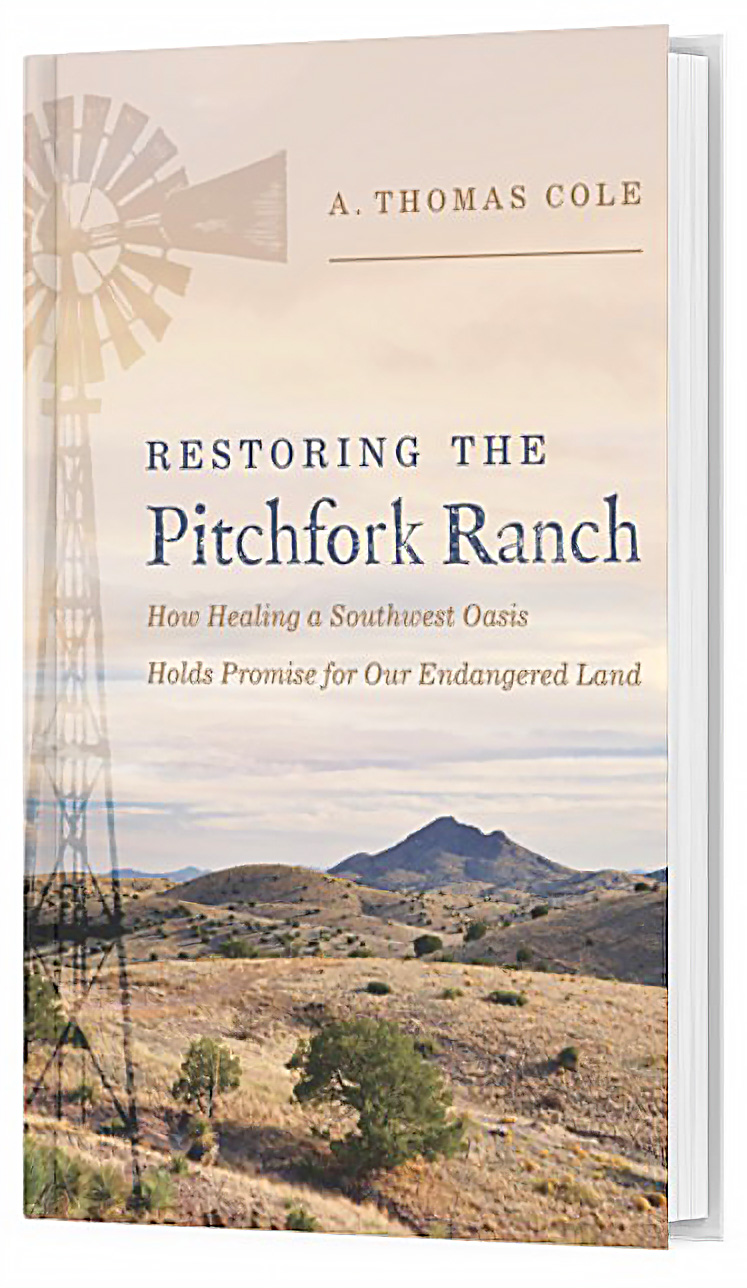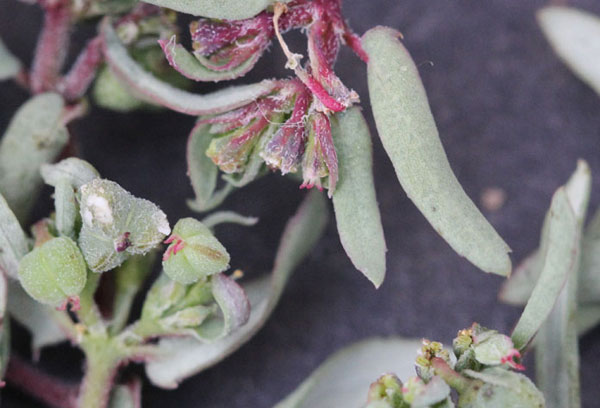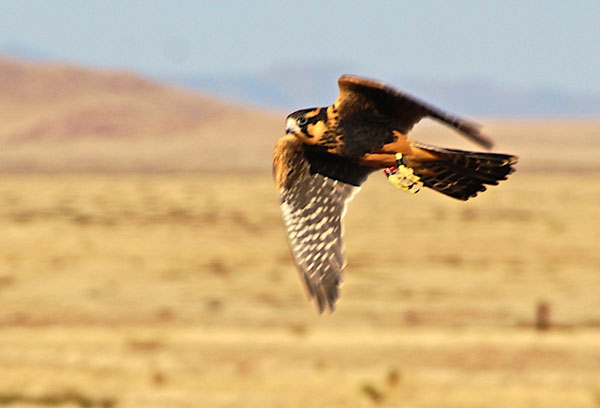Mission Statement
The Pitchfork Ranch is a historic and important place to be restored and repurposed. Fostering improved habitat for wildlife is paramount for this "multi-purpose" ranch — aspiring to be an impact concern — with which, in view of the trifecta of crises — climate breakdown, species extinction and soil depletion — we hope to encourage others to pursue restoration and carbon sequestration.
Returning the land toward its pre-settlement condition, restoring and maintaining its natural processes, addressing these crises, pursuing new thinking about land health via agreement rather than argument are the goals. Learning the workings of the watershed and ciénaga will serve to save this place, ours for only a short time.
Restoring the Pitchfork Ranch
How Healing a Southwest Oasis
Holds Promise for Our Endangered Land
A book by A. Thomas Cole
Now that we have entered the period of boiling, cauldron-like climate weather, the search for solutions beyond abandoning the carbon spewing fossil-fuel merry-go-round has finally hit home. The habitat restoration being done on the Pitchfork Ranch the past two decades is an important solution, but there is more we all can do and Restoring the Pitchfork Ranch, How Healing a Southwest Oasis Holds Promise for Our Endangered Land not only tells the story of the ranch but details how everyone can pursue their climate stabilization potential.
Click here to learn more and order.
Click here to read excerpts from the book.

The Ranch
The off-grid Pitchfork Ranch is located an hour drive southwest of Silver City, New Mexico and has been in beef production since Jerimiah McDonald founded the ranch in 1904. These lands were initially populated by the Mimbres People of the Mogollon culture, verified by the identification of 34 Mimbres habitation sites along the ciénaga, one of which was occupied continuously from 750 CE to 1130 CE. This land later became central to Apacheria. Paintings by the Red-Paint People are shown in the Archaeology sub-section of this section. Next, the Spanish used this land to graze sheep until their departure south after the Mexican-American War of 1846-1848. We want the ranch to not only serve wildlife and preserve it for future generations, but also to encourage others to pursue habitat restoration.Natural-climate solutions increase photosynthesis, the only known way to capture the legacy load of excess carbon in the atmosphere, causing the climate and biodiversity crises that threaten to end civilization, as we know it.
Learn More
Burro Ciénaga
The International Four-Corners region (Arizona, New Mexico, Sonora and Chihuahua) is the only place on Earth that support arid land ciénagas. For several centuries ciénagas were considered a nuisance, some were intentionally destroyed, most dried up and disappeared due to a failure to appreciate their place in the Southwest, not understanding their benefits and importance. There is no way to know their numbers before Spanish arrival, but scholars believe they were in the many hundreds, if not multiple thousands. Up to 95 percent of cienága habitat has been lost. Most of the ciénagas remaining today are but a fraction of their former selves. Those that still have water need restoration, otherwise, they too will likely become extinct.

Euphorbia rayrurneri
It was a surprise when a plant previously unknown to science was discovered on the ranch in 2009. Even though this land had been in cattle production for over a century, it was not severely overgrazed, leaving sufficient vegetation and soil healthy enough to respond to restoration. Even though this plant had been here for thousands of years, it was simply never noticed. For several years, the ranch was the only place on the planet where it was known to exist, although it has now been located at several other locations in New Mexico. Local ornithologist Dale Zimmerman remarked that he was not surprised at the discovery of an unknown species, having visited the area with students for many years, he realized that it was a special place, unstudied and that novelties such as the Euphorbia rayturneri were to be expected.

Wildlife
Although mountainous, this land is primarily rolling Chihuahuan grassland, one of the most biologically diverse arid regions in the world. Scientists, citizen scientists, students and others have so far identified 30 mammals, 25 amphibians, reptiles and fish, 128 birds, 59 butterflies, 563 moths and 342 plants, 64 of which are grasses. Among these numbers are seven at risk or listed species: a bird, a plant, insect, frog, a mammal, a fish and the Euphorbia rayturneri, Red Listed. The restoration has not only improved the ciénaga and surrounds, but has also helped the expansion of herds and flocks of several species already here and the arrival of species we had not seen since our arrival.
Learn More

Cattle
Cattle were grazed on these lands prior to the establishment of the ranch as part of the historic Gray Ranch. Before that, sheep were grazed here by the Spanish and before that Native Americans hunted this land. Because white coated cattle run 15-degrees cooler than those with dark coats, as of 2021, we have narrowed our small herd to one-hundred percent Charolais. While we see cattle ranching important as means of avoiding habitat fracturing and the production of grass grazed and finished beef in the face of stockyard, grain feed cattle’s part of the climate crisis, it is no longer the principal purpose of this ranch. Restoration is now the primary function. We refer to ourselves as “ranch owners” and not “ranchers” as there is a notable difference between retirees using a historic cattle ranch to help thwart the climate, species extinction and soil depletion crises and a “cowman.”
Learn More

Habitat Restoration
Repairing this land has been central to our efforts since retiring to the ranch in 2004. Our focus has expanded with recognition of environmental crises and scientists having made clear that natural-climate solutions can achieve 37 percent of the Paris Climate Accord goals. Improved land use can halp arrest global over-heating at a low cost. Habitat restoration and biodiversity conservation are not only critical for solving the climate, extinction and soil crises, but habitats need restoration if its inhabitants are to persist. Worsening this trifecta of crises, we have entered an “era of pandemics.” Globally, some habitats need to be targeted to repair the barriers and ecological filters that protect humans from the spillover of disease transmission from wildlife. Restoring habitat is about accepting fault for how we have lived on land, rebuilding our relationship with nature, preserving our other planetary companions and ultimately, our own survival.
Learn More

Moment of Truth
We have reached our Moment of Truth. Globally, extreme weather events — hotter, drier and more conducive to fires, floods, hurricanes and other forms of what used to be referred to as natural disasters — have increased dramatically in the past 20 years, with 7,348 major disaster events compared to 4,212 the previous two decades. These seven thousand events claimed 1.23 million lives, affected 4.2 billion people and caused nearly $3 trillion in economic losses. Soil is depleated to the point where, absent significant change in farming practices, its agricultural function will soon be exhausted. Species are going extinct 1000 times faster than their natural rate. Climate, biodiversity and soil are in crisis. We have run out of time. If we maintain the status quo, the future will see the end of civilization, as we know it.
Learn More


